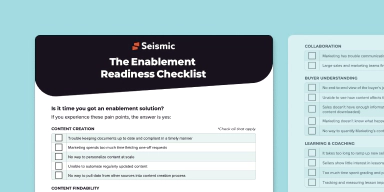FAQ Learning and Coaching
We know the enablement industry can be confusing to navigate. Consult these FAQs or our Glossary of terms to avoid any head-scratching moments.

We know the enablement industry can be confusing to navigate. Consult these FAQs or our Glossary of terms to avoid any head-scratching moments.

At the most basic level, training ensures that employees have foundational skills and knowledge they need for their roles. On the other hand, development refers to the ongoing education, training, and mentoring that helps them grow in their careers over time.
A good sales coach is not just another trainer or mentor for sellers. The job of a good sales coach is to build relationships with sellers in order to help them improve their performance over time. A good sales coach creates a safe and collaborative environment so there is trust and mutual respect between them and their sellers. Because no two sales reps are the same, it’s also important for sales coaches to mix up their coaching styles depending on the individual.
The best way to develop microlearning is to start with a lesson plan that:
Soft skills should be a priority for every business. By incorporating soft skills into your training program, you’ll be able to help employees refine and hone soft skills over time, address specific skills and pain points that they may face in their roles, and give them the opportunity to practice applying the skill. Skill coaching is also a great way to provide valuable and personalized feedback on skill development.
A key step in sales readiness is assessing the current skill sets and abilities of sellers. Once sellers complete essential training and enablement, sales leaders or trainers need to assess and certify a rep’s skill level to ensure they are prepared and ready to do their jobs effectively.


Organizations can deliver online training courses or lessons with online training software. Online training software makes it easy to create, update, and deliver training to employees. Then, they can access training content from any device, any location, and at any time.
Onboarding remote employees can be challenging, but the goals remain the same as if they were in the office. We suggest introducing communication channels, creating a sense of camaraderie, and providing role clarity as early as possible. Online onboarding software is also a great way to deliver essential training to new hires that they can complete from virtually anywhere.
A knowledge management system streamlines the entire knowledge management process. This system helps with creation, storage, and sharing of information. It also allows organizations to connect disparate tools to create one searchable source of accurate information so employees don’t have to jump from tool to tool.
Knowledge management helps new hires and teammates easily find answers to frequently asked questions and important information they may need while on the job. Because they’re empowered to find accurate info on their own, they don’t have to stop to ask other team members questions or waste time searching for answers.
During peer-to-peer training, colleagues train their own teammates. For example, a new hire may be placed with a buddy who they can learn best practices and tips from as they become more familiar with their role.
The length of your microlearning courses will vary depending on the topic, your team’s needs, and learning objectives. Research shows that the optimal lengths for microlearning should be about 13 minutes, but we strongly recommend aiming for 10 minutes if possible.
Microlearning is a great way to deliver training in small doses that employees can complete when it’s best for them. This flexibility effectively engages learners. Additionally, the flexible learning format can include multiple forms of information delivery like video and infographics, which is easy to understand and retain.
Yes! Technology-based training methods are shown to improve information retention rates. The average retention rate for instructor-led training is 58% while online training boosts retention rates to an average of 83%.
It’s important to remember that online training should be flexible and easy to consume. Be sure to break learning up into short, digestible lessons or courses. It’s also a good idea to include different formats like text, video, images, and interactive elements to encourage engagement.
The onboarding process includes four main phases:
Training objectives are the goals or desired outcomes that you want to achieve through training. For some organizations, their objective may be to impart job-related knowledge and skills to employees. For others, the objective of training may be to reinforce or improve behaviors that contribute to the productivity and growth of the organization.
A knowledge manager implements the knowledge management processes in an organization and ensures it’s as effective and efficient as possible. They also own the ongoing maintenance and best practices of the company’s knowledge management system.
Preboarding is the period before a new hire’s first day on the job. This is a great time to send them essential paperwork, helpful tips like what their first day will look like, and other essential information they need to know.
Soft skills training helps employees improve certain traits and attributes like communication, active listening, or problem-solving so they can be more productive and effective in the workplace.
Sales training and sales coaching are closely linked. Training ensures that sellers have the skills they need to contribute to the team. Training also educates sellers on your products, service, or solutions. Sales coaching builds on training to develop skills and close performance gaps over time.
Sales readiness is similar to enablement, but they aren’t the same. Enablement removes barriers for sellers by giving them the tools and content they need. Sales readiness ensures that sellers are equipped with the right skills and knowledge needed to engage prospects.


Sales training is a foundational step of sales readiness. Sales training equips sellers with the skills and information they need to perform in their roles. This includes knowledge about your company’s products, services, processes, and goals. Sales readiness is about making sure sellers are prepared for conversations throughout the entire sales process – training is just one important component.
Soft skills in the workplace help employees build relationships with their teammates, prospects, and customers. Additionally, the right mix of soft skills improves efficiency, engagement, retention, and productivity for organizations.
Because democratization occurs within many organizations, both the company and its employees can reap the benefits from the ideas and knowledge of others. This not only engages team members, but it’s also a great way to collect their working knowledge and turn it into best practices that can be shared across the organization. This leads to enhanced productivity and efficiency.
Peer-to-peer learning is a great way for employees to learn information in a new and engaging way. Additionally it helps organizations:
Sales coaching comes with many advantages and benefits. Teams that deliver personalized coaching improve productivity, increase engagement, and decrease turnover. Additionally, teams experience a 76% increase in closed-won rates when they focus on personalized sales coaching.
There are many reasons why training is important. First, training is a foundational step to ensure employees can do their jobs correctly and efficiently. In fact, companies that invest in training have more engaged employees and see higher profits and growth than companies that don’t focus on training. Additionally, training is a great way to engage employees and decrease turnover.